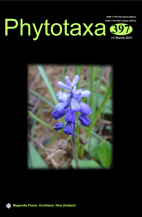Abstract
Fuscidea multispora Flakus, Kukwa & Rodr. Flakus and Malmidea attenboroughii Kukwa, Guzow-Krzemińska, Kosecka, Jabłońska & Flakus are described as new to science based on morphological, chemical and molecular characters. Lepra subventosa var. hypothamnolica is genetically and chemically distinct from L. subventosa var. subventosa and a new name, Lepra pseudosubventosa Kukwa & Guzow-Krzemińska, is proposed due to the existence of Lepra hypothamnolica (Dibben) Lendemer & R.C. Harris. Pertusaria muricata, recently transferred to Lepra, is kept in the genus Pertusaria due to the highest similarity of ITS sequence with members of Pertusaria. The occurrence of Micarea hedlundii in the Southern Hemisphere is confirmed based on molecular evidence from Bolivian population. Lepra pseudosubventosa and Pertusaria muricata are reported as new to South America, and 20 taxa as new to Bolivia. Lepraria stephaniana, previously known only from the type locality, is reported from two more sites. An ascosporic state is reported for the first time for Lepra amaroides, as are new chemotypes. Molecular markers were used to place some sterile, sorediate crustose lichens in the family Graphidaceae. The phylogenetic positions of some sterile Malmidea specimens within Malmidaceae are also discussed.

